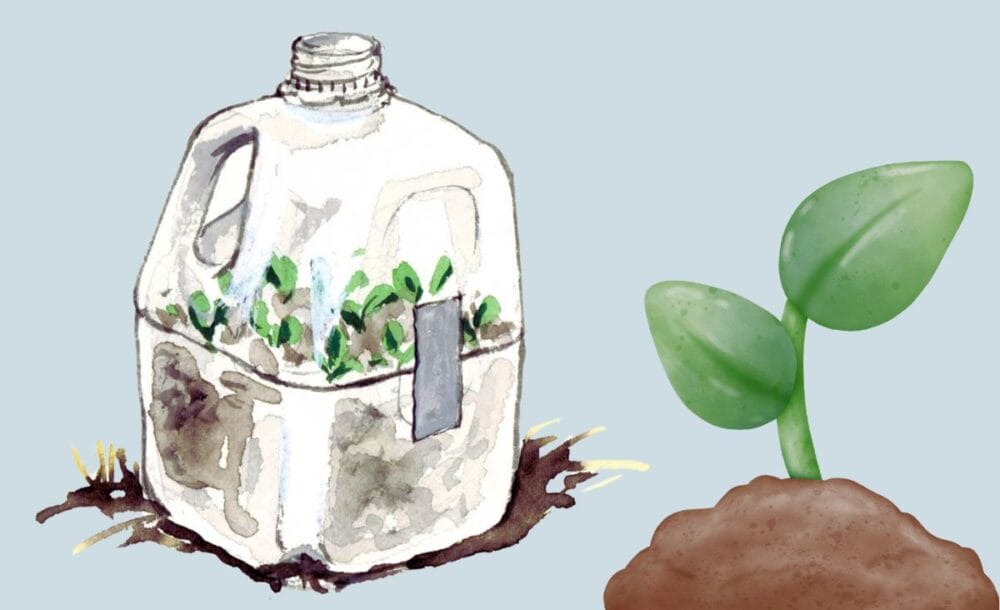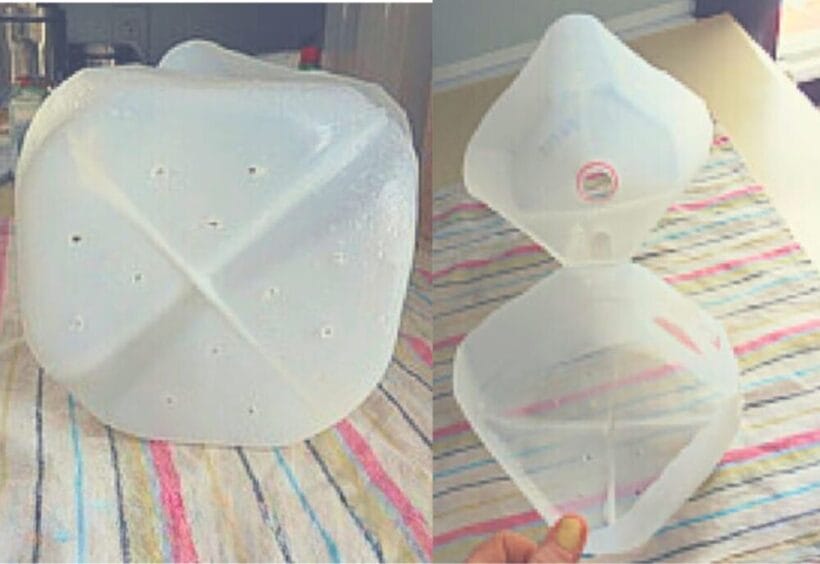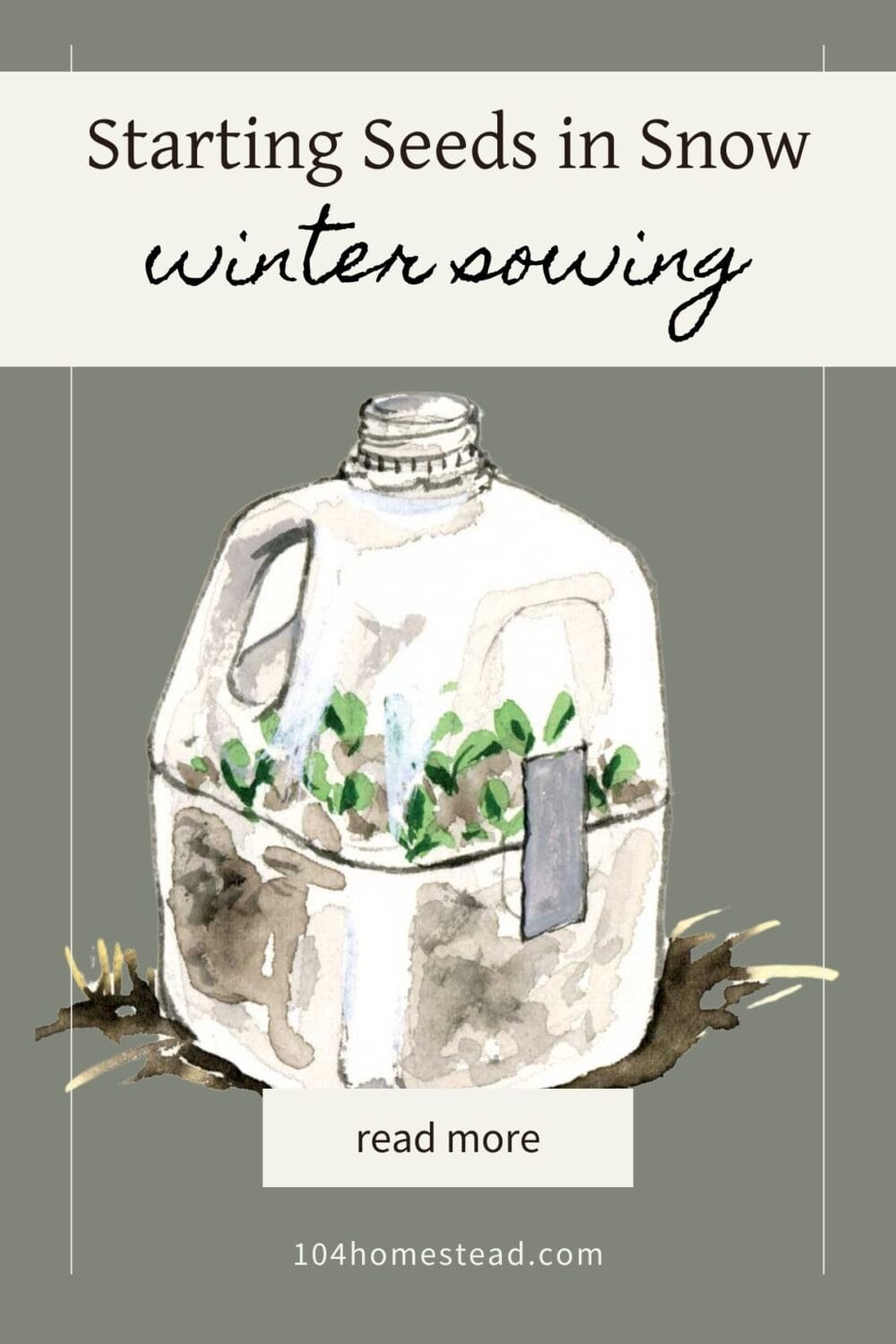A Guide to Winter Sowing {Starting Seeds in Winter}
Winter sowing involves sowing the seeds outdoors in miniature greenhouses during the winter, allowing them to germinate naturally in spring.

Results of a recent social media poll showed that 96% of people who start their plants from seed do so by following the instructions on the back of the packet. They sow seeds in pots in sunny windows 6-8 weeks before the last frost. It makes sense that you would follow the directions, but what if there were an easier and much better way to get those seedlings started?
This guide to winter sowing is like a backstage pass to the magic of gardening—skip the usual routine and embrace a simpler, more effective way to kickstart your seedlings. With its miniature greenhouses and natural germination, winter sowing adds a touch of homestead wisdom to your gardening journey. Whether you’re a first-time veggie gardener or a seasoned pro, the ease of this method is a game-changer. Grab those milk jugs, make some DIY greenhouses, and let your seeds enjoy a winter wonderland until spring bursts forth. Your future garden will thank you for this stress-free start!
What is Winter Sowing?
The idea behind winter sowing is that you sow the seeds outdoors in miniature greenhouses during the winter, allowing them to germinate naturally during the spring. If you live in a northern climate and have snow, this method works even better because the melt adds all the moisture your seeds need. An added bonus to winter sowing over traditional methods: No period of hardening off plants! My biggest downfalls in seedlings are forgetting to water them or over-watering them and then forgetting to bring them in at night when I’m hardening off the plants. This method is perfect for me.
How to Sow Seeds in Winter
So, how does one winter sow? Easily! You need a plastic container to put your seeds in. Some things that work well are large plastic jugs (like the ones pretzels come in), 2-liter soda bottles, or clear plastic take-out containers. It will work as long as it will hold 3-4 inches of soil.
My personal favorite is to use milk jugs. With their shape, you can squeeze a bunch together, and if you save caps/lids, you can regulate watering during heavy spring rains. I will show you how to use a milk jug, but the same rules apply to other containers. First, you need to put drainage holes in the bottom and sides. Being somewhat OCD, I like to do three holes, shaped like a triangle, in each of the four “sections” of the bottom. You also want to place three or four holes about 1/4 – 1/2″ up on the sides. I use the transition of textured plastic to smooth plastic as a guide. There is no set rule for the hole size, but I used a 1/8th drill bit.
Tip: Before drilling holes, fill your container with water and pop it in the freezer or outside until it’s frozen solid. This prevents your container from collapsing when you push the drill bit against it.
After you have all your drain holes in place, you need to make a hinged lid. I used the bottom of my handle as a guide, but with any container, you want your lid to be high enough to allow for 3-4″ of soil. Using a sharp knife and plenty of safety measures, cut across the container, leaving about an inch uncut. This will create a hinge.

Planting in Your Milk Jug
Once you have your greenhouse made, all you do is prepare the soil and seeds. Add your soil and wet it well. Let it drain out the holes you made until the soil is damp but not soaked. Add your seeds according to the packet as far as depth and spacing (though I fudge the spacing and have typically done okay). When you are done, just duct tape the lid closed, remove the cap, and label the outside of the carton with the plant name. If you are using a container that doesn’t have a cap, make sure to put some holes in the top so rain and snow can enter the container.
Placing Your Mini Greenhouses
Once you have everything planted, it’s time to put on your snow boots and jacket to get your greenhouses to their proper place outdoors. The only considerations for placement are that you want your containers to get rain, so don’t put them where they’re under an overhang, and they will need sunlight come spring, so if you can place them in a sunny place now, you won’t have to move them later. I put them right smack in the middle of the front yard.
Because the milk cartons are white, they hardly show up, and after a snow, no one will know they are there. On that note, if you have small children, you may want to mark the area somehow so no one crushes your greenhouses while building a snowman.
When to Start Your Seeds in Maine
This schedule is based on my Maine growing zone, 5b.
January
- Perennial Flowers
- Hardy Annual Flowers
- Brussels Sprouts
February
- Spinach
- Kale
- Peas
- Broccoli
- Thyme
- Sage
- Oregano
- Cilantro
March
- Lettuce
- Carrots
- Basil
- Parsley
- Bok Choy
- Beets
April
- Tomatoes
- Onions
- Peppers
Click Here for zone-specific winter sow planting schedules.
Recommended Reading
Winter Gardening for Beginners by Lindsey Pylarinos
The Winter Harvest Handbook by Eliot Coleman
The Year-Round Vegetable Gardener by Niki Jabbour
See more milk jug upcycling ideas here, and don’t miss one of our most popular upcycling posts, 22 New Uses for Old Pill Bottles.
Frequently Asked Questions
If you’ve found value in this blog post and enjoyed reading it, why not share it with your Pinterest community? Pin the image below and spread the love!

So what are you waiting for? Don’t wait for the last frost. Don’t spend hours counting backward. Throw some seeds in milk cartons and toss them out in the yard. You’ll thank me in the spring.
Have you tried winter sowing in your garden? Share your favorite plants to winter sow or any tips you’ve discovered along the way. If you’re new to this method, what seeds are you excited to try? Let’s swap stories and seed-sowing wisdom in the comments below!
